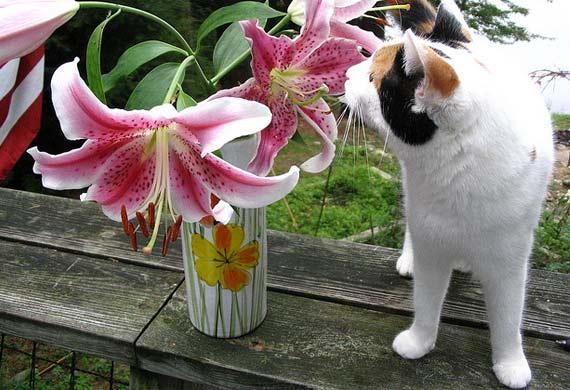Lily Toxicosis
posted: Apr. 19, 2019.

Spring is here!
It’s a favorite time of year for many plants and animals. It is also a popular time for lilies, found in many flower arrangements and gardens. While beautiful, these plants can be very dangerous to our pets. Dogs may only suffer gastrointestinal signs (vomiting, diarrhea) but they can be fatal for cats.
Although the flower is the most toxic part, all parts of the lily plant are toxic, even if just chewed and not ingested. And most would like to think that pets would have a natural instinct to avoid toxic plants, quite the opposite is true. Many cats appear to have an affinity for them and will seek them out even when we think we have put them out of reach.
There are many types of lily (over 160 genera) and many of them are toxic. The biggest culprits are two groups: the true lilies (Lilium genus) and day lilies (Hemerocallis genus), but these two genera include MANY of the popular lilies. When in doubt, it is far safer to assume a variety of lily is toxic since so many of them are.
If you think your cat may have eaten or chewed on a lily, please seek IMMEDIATE veterinary care. When possible, find out what type of plant it is or bring it with you. Do not wait for symptoms to develop. Early symptoms include vomiting, loss of appetite and weakness. These can occur in as little as two hours after exposure. Symptoms may even seem to improve at first before progressing to drooling, stumbling, tremors, and excessive drinking and urinating (in late stages, cats stop drinking and stop urinating).
If treatment is started early enough, many cats can recover. One of the most important aspects of treatment is to reduce absorption of the toxin. This can be done by making the cat vomit, but this only helps if ingestion was recent and many cats do not vomit even when given medications to induce vomiting. Sometimes activated charcoal is also given to help absorb toxin within the gastrointestinal tract. The other crucial aspect of treatment is to flush out the toxin. This is done by giving large quantities of IV fluids for 3 days. Drinking water is NOT sufficient, even if the cat tends to drink a lot.
So please enjoy the beauty that nature brings us this time of year, but make sure to keep your cat (and dog) safe by avoiding any access to lilies.
Lisa Chase, DVM, cVMA
References:
Gwaltney-Brant, Sharon, Lily Toxicosis, Associate Database VIN, 10/10/2015